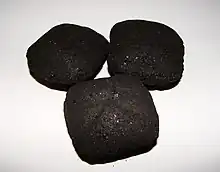Caking
Caking is a powder's tendency to form lumps or masses. The formation of lumps interferes with packaging, transport, flowability, and consumption.[1][2] Usually caking is undesirable, but it is useful when pressing powdered substances into pills or briquettes. Granular materials can also be subject to caking, particularly those that are hygroscopic such as salt, sugar, and many chemical fertilizers. Anticaking agents are commonly added to control caking.

Caking properties must be considered when designing and constructing bulk material handling equipment. Powdered substances that need to be stored, and flow smoothly at some time in the future, are often pelletized or made into pills.
Mechanism
Caking mechanisms depend on the nature of the material. Caking is a consequence of chemical reactions of grain surfaces. Often these reactions involve adsorption of water vapor or other gases. Crystalline solids often cake by formation of liquid bridge between microcrystals and subsequent fusion of a solid bridge. Amorphous materials can cake by glass transitions and changes in viscosity. Polymorphic phase transitions can also induce caking.[1] The caking process can involve electrostatic attractions or the formation of weak chemical bonds between particles.

Anticaking agents
Anticaking agents are chemical compounds that prevent caking. Some anticaking agents function by absorbing excess moisture or by coating particles and making them water-repellent. Calcium silicate (CaSiO3), a common anti-caking agent added to table salt, absorbs both water and oil. Anticaking agents are also used in non-food items such as road salt,[3] fertilisers,[4] cosmetics,[5] synthetic detergents,[6] and in manufacturing applications.
References
- Mingyang Chen; Songgu Wu; Shiji Xu; Bo Yu; Mohannad Shilbayeh; Ya Liu; Xiaowen Zhu; Jingkang Wang; Junbo Gong (2018). "Caking of Crystals: Characterization, Mechanisms and Prevention". Powder Technology. 337: 51–67. doi:10.1016/j.powtec.2017.04.052.
- Lück, Erich; von Rymon Lipinski, Gert-Wolfhard (2000). "Foods, 3. Food Additives". Ullmann's Encyclopedia of Industrial Chemistry. doi:10.1002/14356007.a11_561. ISBN 978-3-527-30385-4.
- "Anticaking Admixtures to Road Salt". Transportation.org. Retrieved 2010-06-17.
- "Fertilizer compositions containing alkylene oxide adduct anticaking agents". Google.com. Retrieved 2010-06-17.
- "Talc Information". Cosmeticsinfo.org. Retrieved 2010-06-17.
- "Synthetic Detergents: Introduction to Detergent Chemistry". Chemistry.co.nz. 2006-12-15. Archived from the original on 26 May 2010. Retrieved 2010-06-17.